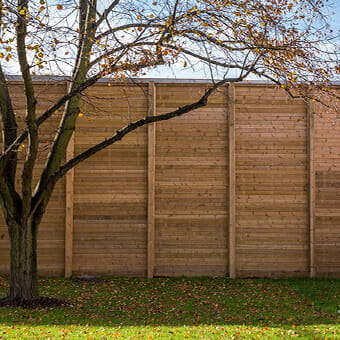Our other sites:
How does acoustic fencing work?
Whether it’s noisy neighbours, the sound of busy roads, or the hubbub associated with commercial premises, acoustic fencing is an ideal solution in a wide variety of situations.
There are different types of acoustic barriers available, but we choose to manufacture our acoustic barriers from timber because of its strength, natural aesthetic and its ability as a material to be transformed into an excellent barrier to noise.
All our acoustic barriers come with a 25 year guarantee, due to our unique Jakcure® preservative pressure treatment, which protects against all forms of wet and dry rot, and insect attack.
But how do they work?
There are two main types of acoustic barriers available - reflective and absorptive. As the names suggest, reflective barriers reduce noise by reflection, while absorptive barriers reduce noise through absorption. The principle design of the two different types is the same: V shaped timber boards that interlock to minimise gaps that sound could travel through, slotted into strong timber or steel I beams depending on the height. With Jakoustic® Reflective barriers, sound waves reflect off the flat profile of the fence, reducing noise by up to 28dB. Jakoustic® Absorptive has an additional layer of absorptive mineral fibre on one side, which traps and breaks down sounds, reducing noise levels by up to 32dB.
In virtually every application for an environmental noise barrier, at least one reflective plane will be present from which sound can be reflected or absorbed by introducing a barrier of sufficient mass. The way sound travels is disrupted, therefore reflecting it off the face of the barrier or absorbing through the fibrous layer.
The effectiveness of an acoustic barrier is determined by five main factors:
Material density and barrier construction relate to sound transmission in practical terms, the greater the mass of the barrier the less the sound. However, the structural integrity of the barrier is critical to its performance as gaps will allow sound to find a direct path through the barrier – therefore it is vital that acoustic fencing should be constructed with no air gaps and sealed to the ground to prevent sound leaking through. On top of this, acoustic barriers should be placed as close as is conveniently possible to the source of the noise to obtain optimum performance.
Available styles of acoustic fencing
*Jakoustic Reflective barrier certified laboratory results: Rating according to BS EN 1793-2:1998 Category = B3 Laboratory sound reduction 28 dB Superficial mass 25kg/m²
**Jakoustic Absorptive barrier certified laboratory results: Category B3 rating according to BS EN 1793-2:1998
Category A3 rating according to BS EN 1793-1:1998
Laboratory sound reduction 32 dB Approximate Superficial Mass 28kg/m²
Take a look at the video below to hear the massive difference Jacksons acoustic fencing can make. (Make sure you have sound on!)
Acoustic Barrier Range
We manufacture a range of acoustic barriers to suit the requirements of different applications, all with a 25 year guarantee.
View RangeTop












